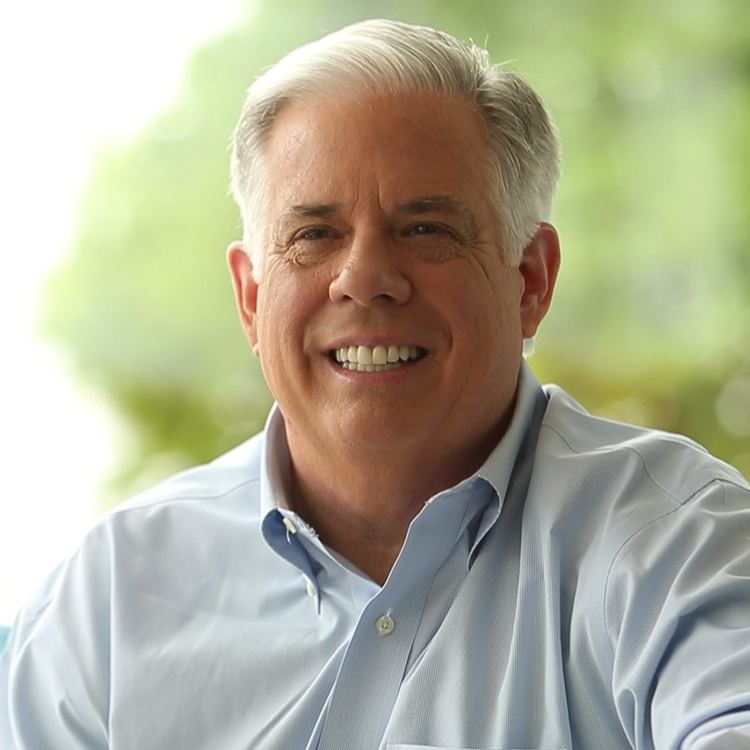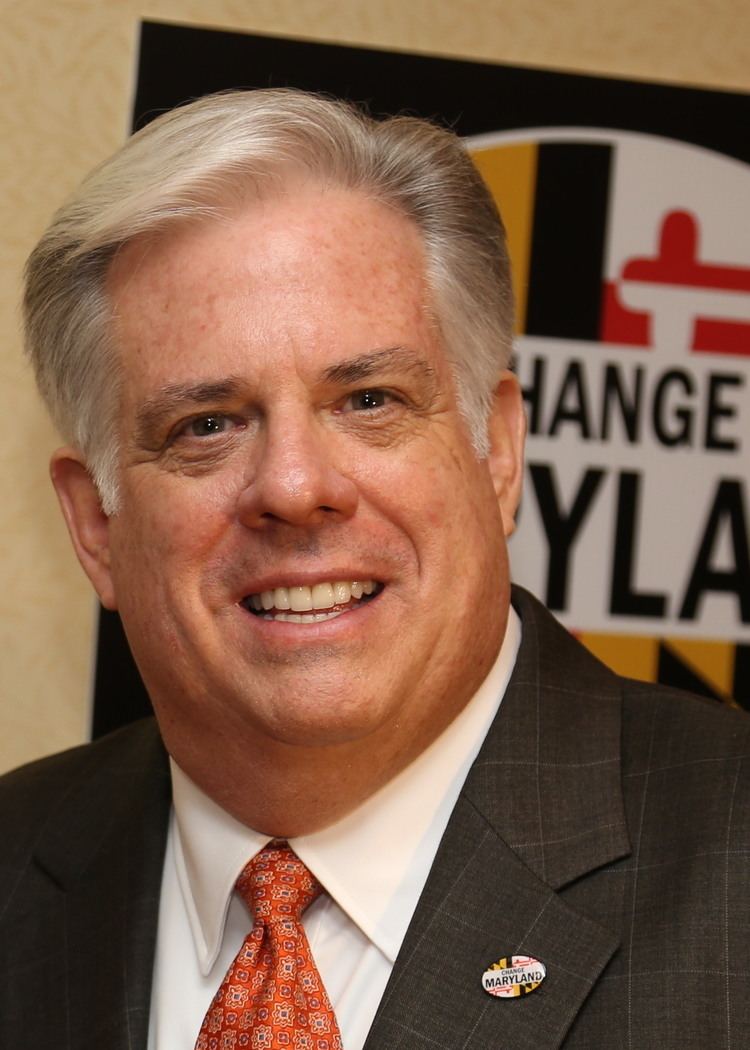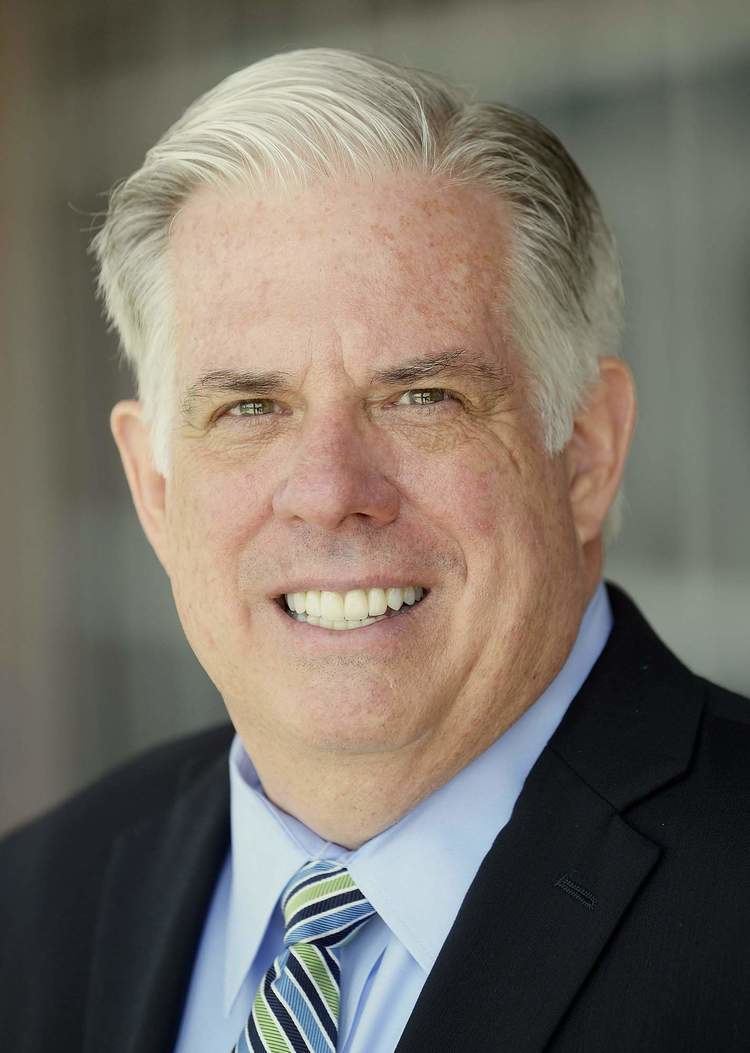Religion Roman Catholicism | Name Larry Hogan | |
 | ||
Full Name Lawrence Joseph Hogan, Jr. Children Kim Velez , Jaymi Sterling , Julie Kim Siblings Patrick N. Hogan , Terry Hogan Similar Yumi Hogan, Lawrence Hogan, Ralph Northam Profiles | ||
Maryland governor larry hogan responds to baltimore riots
Lawrence Joseph Hogan Jr. (born May 25, 1956) is an American politician who currently serves as the 62nd Governor of Maryland, in office since January 2015. He is only the second Republican governor in Maryland in nearly 50 years, and the first Maryland governor from Anne Arundel County to be elected in over 100 years. He previously served as Secretary of Appointments in the administration of Governor Bob Ehrlich from 2003 to 2007. In 2011, Hogan founded the grassroots organization Change Maryland.
Contents
- Maryland governor larry hogan responds to baltimore riots
- Governor larry hogan announces maryland tax toll rollback plan
- Early life and education
- Business career
- Civic and political career
- 1981 Congressional special election
- Congressional nominee
- Cabinet secretary
- Change Maryland
- 2014 gubernatorial campaign
- Tenure
- Environment
- 2015 Baltimore protests
- Baltimore Red Line cancellation
- Transportation scoring bill
- Police and incarceration
- 2016 presidential election
- Executive order for post Labor Day school start date
- Baltimore City schools budget crisis
- Approval ratings
- Facebook controversies
- Sick leave legislation
- Personal life
- References

Governor larry hogan announces maryland tax toll rollback plan
Early life and education

Hogan was born in 1956 in Washington, D.C. and grew up in Landover, Maryland, attending Saint Ambrose Catholic School and DeMatha Catholic High School. He moved to Florida with his mother after his parents divorced in 1972 and graduated from Father Lopez Catholic High School in 1974. Hogan's father, Lawrence Hogan, Sr., served as a U.S. Congressman from Maryland's 5th congressional district from 1969 to 1975 and as Prince George's County Executive from 1978 to 1982.

Hogan attended Florida State University from 1974 to 1978 and earned a Bachelor of Arts degree in government and political science. While in college, Hogan worked in the Florida State Legislature and upon graduation, worked on Capitol Hill. Hogan helped his father run a successful campaign in 1978 for Prince George's County Executive and later worked for his father as a low-paid 'intergovernmental liaison'.
Business career
Hogan founded his real estate business, Hogan Companies, in 1985. He would spend the next eighteen years in the private sector.
Civic and political career
As the son of a U.S. Congressman, Hogan was exposed to politics at a young age and worked in many aspects of politics including political campaigns and citizen referendums. Hogan served as a delegate to the Republican National Convention in the seventies and eighties.
1981 Congressional special election
A 24-year-old Hogan first ran for office in the 1981 special election to fill the vacancy in Maryland's 5th congressional district left by Gladys Noon Spellman. Spellman had succeeded Hogan's father in the congressional seat. Hogan finished second out of twelve candidates in the Republican primary with 22.38% of the votes to Audrey Scott's 63.26%.
Congressional nominee
In the 1992 election cycle, Hogan was the Republican nominee for Maryland's 5th Congressional District, running against Democratic Incumbent Steny Hoyer. The race was the closest in Hoyer's tenure, with Hogan winning four out of the district's five counties and taking 45% of the vote to Hoyer's 55%. No other challenger has come as close to unseating Hoyer since.
Cabinet secretary
Hogan took a temporary leave of absence from his business to serve as Secretary of Appointments in the Bob Ehrlich Administration from 2003 to 2007. In this capacity, Hogan appointed over 7,000 individuals to positions at every level of government.
Change Maryland
In 2011, Hogan founded Change Maryland, a non-partisan grassroots organization. Hogan was chair of the group. The anti-tax organization was a frequent critic of tax increases in Maryland during O'Malley's tenure.
2014 gubernatorial campaign
Hogan formally announced his campaign for Governor of Maryland on January 21, 2014. On January 29, 2014, Hogan announced his running mate, former Maryland Secretary of General Services Boyd Rutherford. On June 24, 2014, Hogan and Rutherford won the Republican primary, receiving 43% of the vote. They faced and defeated the Democratic nominee, Lt. Governor Anthony Brown on November 4, 2014.
Tenure
In the early months of his administration, Governor Hogan earned a reputation as a centrist and pragmatist. In an editorial after Hogan's first four months as governor, the Baltimore Sun said, "Mr. Hogan may prove to be the nation's most pragmatic Republican governor, or at least its least predictable. But the one thing that's certain is that he's no ideologue." Maryland's other major newspaper, The Washington Post, said, "Larry Hogan, who never held elective office before voters chose him last fall, was true to his promise to govern from the center in the first legislative session of his term."
Environment
In an attempt to balance pollution regulations on the Maryland's farming industry, in February 2015 Hogan brought together agricultural and environmental stakeholders and enacted the most important environmental initiative in a generation to protect the Chesapeake Bay: the "Maryland Agriculture phosphorus Initiative," creating both looser and stricter regulations for farmers on Maryland's Eastern Shore. Described by the administration as "enhanced phosphorus management tool regulations," the proposal came with two key elements: A process to give farmers more time to reduce phosphorus output on their farms and a measure that immediately stopped many farmers from contributing more to the ongoing problem of pollution in the Chesapeake Bay.
In June 2017, Hogan maintained support for the Paris Agreement, claiming that he would not have made the same decision as President Trump to pull out of the accord. In 2016, Hogan signed legislation to reauthorize greenhouse gas reduction targets and mandate a 40 percent reduction in statewide carbon pollution by 2030. He has not joined the United States Climate Alliance formed by California, New York, and Washington.
2015 Baltimore protests
Following the death of Freddie Gray, a 25-year-old African American resident of Baltimore, Maryland, civil unrest broke out in Baltimore city on April 27, 2015. To address the growing unrest, Governor Hogan declared a state of emergency and activated the Maryland National Guard. Major General Linda Singh of the Maryland National Guard commented that there would be a "massive number" of soldiers in Maryland on the night of April 27, and that up to 5,000 soldiers were eventually deployed. Maryland State Police activated 500 officers for duty in Baltimore, and requested additional state police officers from other states. During the unrest, Gov. Hogan temporarily moved his office from Annapolis to Baltimore, where the Governor and his staff remained throughout the state of emergency.
Baltimore Red Line cancellation
In June 2015, Hogan cancelled the federally-funded Baltimore Red Line project, instead choosing to reallocate money to road construction across Maryland, fulfilling a campaign promise to voters who elected him in 2014. Maryland Transportation Secretary Pete Rahn described the Red Line proposal as "fatally flawed" and argued that the light rail line would not connect with other public transportation hubs in Baltimore and would require the construction of a $1 billion tunnel through the heart of the city. Although, plans detailed the Red Line would in fact connect to the MARC Train at the West Baltimore station and planned Bayview station, the Baltimore Metro Subway at Charles Center station via a pedestrian tunnel, and with the Baltimore Light Rail at the University Center/Baltimore Street station at street level. Baltimore Mayor Stephanie Rawlings-Blake criticized the scrapping of "a project that would have expanded economic development, created thousands of jobs, increased access to thousands more, and offered residents better health care, child care and educational opportunities." At the same time, Hogan conditionally approved funding for the Purple Line in Maryland's Washington, D.C. suburbs, subject to increased contributions from Montgomery County and Prince George's County.
The anticipated reduction in Purple Line costs, combined with the availability of funding allocated for the Red Line, made it possible for the Hogan administration to commit to $1.97 billion for highways and bridges across the state of Maryland, including rural areas in both Western Maryland and the Eastern Shore, as well as the densely populated counties near Baltimore and Washington D.C. The projects, which will get underway by 2018, include $1.35 billion in new projects going to construction and $625 million in preserved projects. The $1.35 billion in new projects includes $845 million for major projects and $500 million to fix bridges and improve roads.
Transportation scoring bill
In 2016, the Maryland General Assembly introduced HB 1013, the Maryland Open Transportation Investment Decision Act of 2016, which aims to establish statewide transportation goals through a transparent scoring process by the Maryland Department of Transportation. Inspired by Hogan's decision to cancel the Baltimore Red Line and shift funding to rural areas of the state, the legislation would require the Transportation Department to develop a project-based scoring system and promulgate regulations for the public.
On April 1, 2016, Hogan vetoed the bill claiming it was politically-motivated and that it would increase the cancellation risk for major transportation projects throughout the state. Hogan himself has relabeled this legislation as the "Road Kill Bill", because it will force him to cancel numerous major transportation projects, especially in the Baltimore and Washington regions. Despite Hogan's rhetoric, the legislation would not prevent the Governor from having the final determination on a project. The General Assembly overrode Hogan's veto on April 8, 2016. Hogan has deemed repealing the legislation to be his top priority, but gridlock and tension between the Governor and the legislature has prevented compromise on moving forward with the bill.
Police and incarceration
In July 2015, Hogan announced the "immediate" closure of the decrepit Baltimore City Detention Center, which had a long record of poor conditions and dysfunction. Hogan did not notify Baltimore City mayor Stephanie Rawlings-Blake or leaders of the state general assembly about the plan. Hogan's move was supported by civil liberties and reform groups such as the American Civil Liberties Union, Public Justice Center, and Justice Policy Institute.
In 2016, Hogan re-opened the Maryland State Police Barrack in Annapolis, which had previously been closed in 2008 as a cost-savings measure.
2016 presidential election
On July 15, 2015, Hogan endorsed New Jersey Governor Chris Christie in his campaign for the Republican nomination for the presidency. However, in June 2016, Hogan stated that he had no plans to support Donald Trump, the Republican Party's presumptive nominee, despite the fact that Trump had previously been endorsed by Christie.
Hogan instead wrote in his own father, Lawrence Hogan (a former congressman and county executive of Prince George's County) for president. Hogan did, however, attend Trump's inauguration as president.
Executive order for post-Labor Day school start date
On August 31, 2016, Hogan issued an executive order to set the public schools start date after the Labor Day holiday. The Maryland State Education Association (MSEA) stated that Hogan's executive order would help the tourism industry, and harm students in the classrooms as a result. However, the measure was extremely popular with Marylanders in both parties and across multiple demographic groups. One month after the measure was introduced and criticized by Teachers' Union and other political advocacy groups, close to 70 percent of Maryland residents were still in favor of a post-Labor Day start for public schools. Research promoted by MSEA has shown that a post-Labor Day start to the school year prolongs summer brain drain, and makes it difficult for students to return to their studies. MSEA also remarked that this change would harm low-income families, due to the increased costs of paying for child care. Conversely, a bi-partisan commission formed in 2013 to include teachers, parents, political leaders, business leaders and local school officials outlined numerous benefits to a Post-labor Day start and voted overwhelimingly (12–3) to recommend the measure to then Governor Martin O'Malley.
Baltimore City schools budget crisis
In early 2017, Governor Hogan's budget severely undercut funding for community revitalization programs, extended library hours, and public schools in Baltimore City. Under the proposed budget, Baltimore City Public Schools would receive $42 million dollars less than they already receive, further inundating the current $129 million budget gap. In response to the city schools funding crisis, educators, students, parents, celebrities, and citizens have reached out to their local legislators, the Governor and Baltimore Mayor Catherine Pugh to find a solution, with many using the hashtag #FixTheGap. Hogan has criticized the school system for the mismanagement of funds, and has deemed the system's finances an "absolute disaster".
Approval ratings
Hogan has enjoyed high approval ratings. A March 2016 Gonzales Poll showed Hogan holding a 71% approval rating in a state in which Democrats outnumber Republicans 2–1, despite some friction with the state's Democratic legislature. A Washington Post-University of Maryland poll in April 2016 showed Hogan with a 66% approval rating, making him the most popular governor of Maryland since 1998. Hogan's favorable numbers were attributed to the improving economy in the state and Hogan's decision to govern "as a moderate, focusing on taxes and other pocketbook issues while avoiding polarizing social topics such as abortion or religious-objection laws."
Facebook controversies
Since taking office, Hogan's Facebook page had blocked over 450 people from accessing the page for communication purposes, as of February 2017. One spokesman said about half had used "hateful or racist" language, while the rest were part of a "coordinated attack". Affected Marylanders said they had reached out to the governor via Facebook following the 2015 Baltimore protests, as well as the controversial travel ban ordered by President Donald Trump in January 2017.
In March 2017, it was discovered that Hogan staffers altered headlines of Baltimore Sun and DelmarvaNow articles posted in the governor's Facebook page to falsely imply General Assembly support for the Governor's so-called "Road Kill Bill"; after the Sun contacted the governor's office about the doctored headlines, the governor's office rectified the problem.
Sick-leave legislation
In December 2016, Hogan proposed state legislation to require large companies (those with 50 or more employees) to provide five days a year of paid sick leave. Hogan's bill was less expansive than legislation passed by the Democratic-controlled House of Delegates; it also would have preempted local legislation that was more generous to employees, such as mandated paid sick leave required by Montgomery County. In the legislature, Hogan's proposal failed to advance out of committee, and the House of Delegates passed more expansive legislation that would require companies with 15 employees or more to give seven paid sick-leave days a year, requires companies with fewer than 15 employees to provide five days of unpaid sick leave, and would afford benefits for part-time employees.
Personal life
Hogan resides in Government House in Annapolis and his private residence in Anne Arundel County along with his wife Yumi, a Korean-American artist and adjunct instructor at Maryland Institute College of Art. The couple met in 2001 and married in 2004. Yumi is the mother of three adult daughters – Kim Velez, Jaymi Sterling, and Julie Kim – with whom Hogan immediately formed father-daughter relationships. Hogan's brother, Patrick N. Hogan, represented a Frederick County district in the Maryland House of Delegates from 2003 to 2007 and 2011 to 2015.
On June 22, 2015, Hogan announced that he had been diagnosed with late stage 3 non-Hodgkins lymphoma, which he described as "very advanced and very aggressive". Talking about his cancer diagnosis, Hogan said, "It's one that responds very aggressively to chemotherapy treatment. There's a strong chance of success." Bone marrow test results announced several days later showed that the cancer was at stage 3; Hogan began four days of chemotherapy on June 27, 2015 and completed a series of treatment on October 13, 2015 after six rounds. Hogan announced on November 16, 2015, that medical scans showed no sign of the cancer that he was diagnosed with five months earlier, indicating that 18 weeks of intensive chemotherapy put the disease into remission. His last chemo treatment was about a year later on October 3, 2016.
